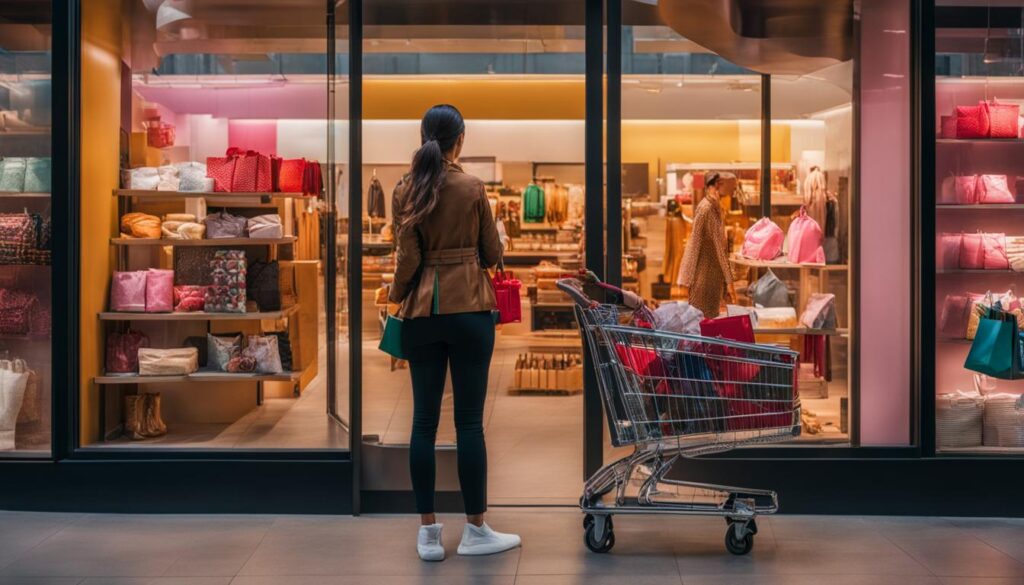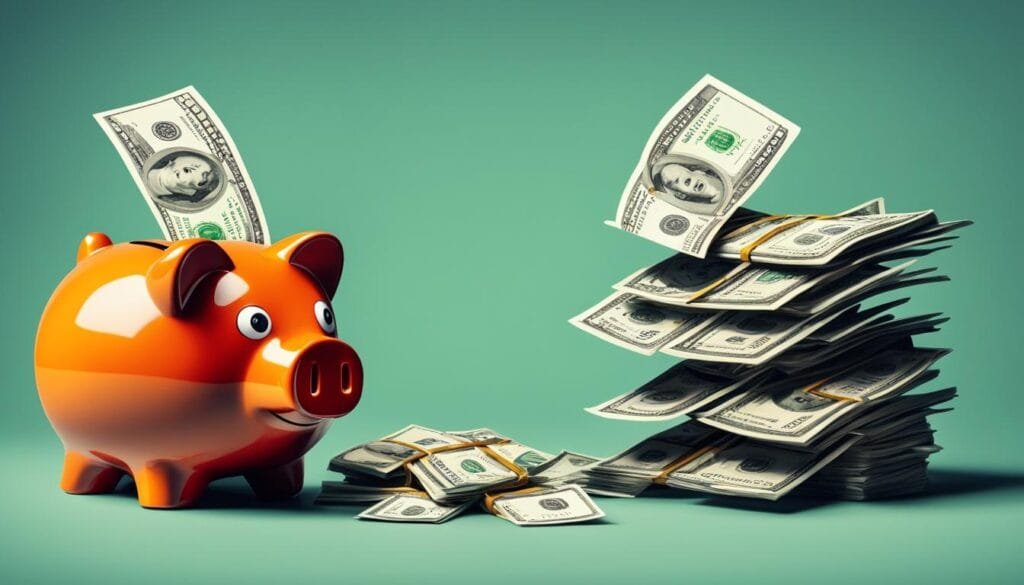Impulse buying is a fascinating phenomenon that greatly influences consumer behavior. Understanding the seven phases of impulse buying provides valuable insights into consumers’ spontaneous purchase decisions and the psychology behind them. By delving into these phases, brands can gain a deeper understanding of their customers’ buying patterns and tailor their marketing strategies accordingly.
The impulse buying process consists of seven distinct phases that consumers go through before making a spontaneous purchase. These phases include triggers, interest and attention, desire, justification, purchase, post-purchase evaluation, and reflection and learning. Each phase plays a crucial role in shaping the consumer’s decision-making process and eventual purchase.
Key Takeaways:
- Impulse buying involves seven phases that lead consumers to make spontaneous purchases.
- The triggers phase is where consumers are initially enticed by stimuli, such as eye-catching displays or enticing offers.
- In the interest and attention phase, consumers start considering the value and benefits of the product.
- Desire emerges when consumers emotionally connect with the product and envision it as a valuable addition to their lives.
- Justification involves rationalizing the purchase to align with logical scrutiny and validate the consumer’s decision.
The Trigger: The First Phase of Impulse Buying
The trigger is the starting point of the impulse purchase cycle. It can be a dazzling display, a tempting offer, or a captivating advertisement. Identifying these triggers is crucial for brands to capture spontaneous interest and engage with consumers. Various psychological factors and personality traits, such as low self-esteem and a tendency towards compulsive buying behavior, can make individuals more susceptible to impulse buying.
Understanding the triggers that prompt impulse buying behavior allows brands to strategically position their products or services to appeal to consumers in the right moment. By leveraging effective marketing techniques, brands can create a sense of urgency, ignite desire, and stimulate impulsive purchases.
Interest and Attention: The Second Phase of Impulse Buying
After the trigger, consumers’ attention is snagged, and their interest starts to pique. It’s during this phase that the product transforms from being just another item on the shelf to something worth a closer look. The consumer becomes curious and starts considering the potential benefits and value of the product.
During the interest and attention phase, various factors contribute to capturing and maintaining the consumer’s focus. Eye-catching packaging, attractive displays, and persuasive advertising play an essential role in drawing the consumer’s attention to the product. Additionally, the consumer’s personal interests, needs, and desires play a significant role in determining what captures their attention.
When consumers are exposed to stimuli that resonate with their preferences, desires, or aspirations, their interest intensifies. The right combination of visuals, messages, and emotional triggers can create a powerful connection between the consumer and the product. This connection sparks fascination and stimulates the consumer’s imagination, making them envision how the product can enhance their lives.
Brands leveraging this phase of impulse buying often employ strategies that emphasize the uniqueness, exclusivity, or rarity of the product. Limited-time offers, limited edition releases, or products that cater to specific trends or interests can create a sense of urgency and amplify the consumer’s desire.
“The customer may not always be aware that their interest is being influenced or manipulated,” explains Sarah Thompson, a consumer behavior expert. “Effective marketing techniques can captivate the consumer’s attention and generate a compelling interest in the product, leading to an impulse purchase.”
As consumers start evaluating the potential benefits and value of the product, they may conduct internal deliberations, comparing the product to alternatives, taking into account factors such as price, quality, and convenience. However, it’s important to note that impulse purchases are often driven more by emotion than by rational thinking during this phase.
The image below showcases an example of how effective visual merchandising and attention-grabbing signage can influence consumers’ interest and attention:
 |  |
Through careful attention to capturing consumer interest during this phase, brands can increase the likelihood of converting interest into desire and ultimately drive impulse purchases.
Desire: The Third Phase of Impulse Buying
Once the initial interest is piqued, consumers quickly transition into the phase of desire. During this stage, the psychology of impulse buying takes center stage, as consumers envision the product as something that would greatly enhance their lives. It is in this phase that the seeds of purchase are sown, as a sense of longing and emotional attachment to the product takes hold.
The psychology of desire in impulse buying decision-making is fascinating. Consumers are driven by their innate desires for pleasure, status, and fulfillment. They associate the product with positive emotions and imagine the satisfaction they would experience by owning and using it.
In this highly influential phase, marketers leverage various strategies to capitalize on consumers’ desires. They create compelling visual representations, engaging storytelling, and persuasive messaging that appeal to the psychological needs and aspirations of the target audience. By highlighting the product’s benefits, unique features, and exclusivity, they enhance the consumer’s perception of value and desirability.
Understanding the psychology of desire is integral to shaping effective marketing campaigns and optimizing impulse buying experiences. By tapping into the consumer’s emotional connection and emphasizing the product’s ability to fulfill their desires, marketers can significantly influence the impulse buying decision-making process.
“During the desire phase, consumers experience an intense longing for the product, fueled by emotional attachment and the anticipation of the pleasure it would bring.”
Here is a visual representation of the third phase of impulse buying:
| Phase | Description |
|---|---|
| Trigger | The starting point of the impulse buying cycle, where consumers encounter something that sparks their interest. |
| Interest and Attention | Consumers become curious and start considering the potential benefits and value of the product. |
| Desire | Consumers transition from curiosity to an intense longing for the product, driven by emotional attachment and the anticipation of pleasure. |
| Justification | The consumer’s mind aligns the heart’s whims with logical scrutiny, aiming to validate the impending purchase. |
| Purchase | The consumer moves from curiosity to becoming an owner of the product, making the spontaneous purchase. |
| Post-Purchase Evaluation and Reflection | The consumer reflects on their decision and evaluates the worthiness of their impulse purchase. |

Justification: The Fourth Phase of Impulse Buying
Even in spontaneity, a hint of justification often seeks to validate the impending purchase. The consumer’s mind starts aligning the heart’s whims with logical scrutiny. Justifying the purchase can involve rationalizing the need or convincing oneself of the value and benefits of the product.
Psychological Factors Influencing Justification
During the justification phase of impulse buying, several psychological factors come into play. These factors can influence the consumer’s decision-making process and ultimately lead to the purchase. Some key psychological factors include:
- Self-Perception: Consumers may justify their impulse purchases by associating the product with their self-image or desired identity.
- Social Influence: The opinions and actions of others can impact the consumer’s justification process. If friends or influencers endorse the product, it can validate the purchase.
- Emotional Gratification: Justification often stems from the emotional satisfaction that the consumer expects to derive from owning the product. They convince themselves that the purchase will bring happiness or fulfillment.
Research on Impulse Buying Justification
Impulse buying has been the subject of extensive research, including studies specifically focused on the justification phase. Researchers have sought to understand the factors that contribute to impulse buying decision-making and the strategies consumers use to validate their spontaneous purchases.
“Research on impulse buying justification has revealed that consumers engage in cognitive processes to rationalize their impulsive actions. They weigh the pros and cons, distort information, or seek external validation to alleviate any feelings of guilt or regret.”
– Dr. Jane Carter, Consumer Behavior Researcher
This research has shed light on various aspects of impulse buying justification, such as the role of individual differences, situational factors, and the impact of marketing tactics. By gaining insights into the justification phase, brands can better understand and influence consumers’ decision-making, ultimately maximizing their chances of converting impulse buying intentions into sales.
Justification Strategies for Impulse Buying
| Justification Strategy | Description |
|---|---|
| Need Rationalization | Consumers convince themselves that the product fulfills a genuine need, even if it’s not a primary requirement. |
| Value Proposition | Consumers highlight the perceived value and benefits of the product, emphasizing that the purchase is worthwhile. |
| Opportunistic Mindset | Consumers view the impulse purchase as a rare opportunity or a special deal that they can’t pass up. |
| Emotional Justification | Consumers rely on the emotional satisfaction they expect to derive from owning the product. |
The Purchase: The Fifth Phase of Impulse Buying
Once the consumer has gone through the stages of impulse buying, from the initial trigger to developing interest and desire, they reach the defining moment: the purchase. This is when they transition from being intrigued by the product to becoming its proud owner.
For the consumer, making the spontaneous purchase brings a sense of fulfillment and satisfaction. It validates their decision to indulge in their impulse and adds excitement to their shopping experience. The act of buying gives them a sense of gratification, as they acquire the item they desire.
Similarly, for the brand, the purchase is a significant accomplishment. It represents a successful conversion of interest into a sale. The brand’s marketing efforts, including captivating triggers, attention-grabbing advertisements, and persuasive messaging, have paid off.
The purchase phase is crucial for both the consumer and the brand. For the consumer, it marks the fulfillment of their impulsive urge and the satisfaction of acquiring the desired product. For the brand, it represents a successful transaction and the opportunity to build a relationship with the consumer for future purchases.
Do the 7 Phases of Impulse Buying Apply to Luxury Goods Purchases?
When it comes to luxury goods purchases, the 7 phases of impulse buying still apply. Despite the high price tag, the allure and prestige of luxury goods appeal to consumers on an emotional level. Understanding the psychological facts behind impulse buying can help luxury brands attract and retain customers.
Post-Purchase Evaluation and Reflection: The Final Phases of Impulse Buying
Once the purchase is made, consumers enter the crucial phase of post-purchase evaluation and reflection. During this phase, individuals take a moment to contemplate and assess the decision they made regarding their impulse purchase. Reflecting on the worthiness of the product and evaluating their overall satisfaction are key elements of this evaluation process.
Consumer satisfaction is a common outcome of impulse buying behavior. The excitement and instant gratification that come from making a spontaneous purchase can lead to feelings of contentment and delight. On the other hand, some individuals may experience buyer’s remorse, where doubts and second thoughts arise after the purchase. Both satisfaction and buyer’s remorse play a role in shaping consumers’ perceptions and future buying behaviors.
The post-purchase evaluation and reflection phase also serve as a valuable checkpoint for future brand interactions. Consumers learn from their impulse buying journey and gather insights that may guide their future decisions. By analyzing their experience and assessing the value they derived from the impulse purchase, individuals can become more informed and deliberate consumers, influencing their buying patterns and preferences.
FAQ
What are the seven phases of impulse buying?
The seven phases of impulse buying are triggers, interest and attention, desire, justification, purchase, post-purchase evaluation, and reflection and learning.
What is the trigger phase in impulse buying?
The trigger phase is the starting point of the impulse purchase cycle, where consumers are influenced by displays, offers, or advertisements.
How does interest and attention play a role in impulse buying?
Interest and attention are the second phase of impulse buying, where consumers become curious and consider the potential benefits and value of a product.
What is the role of desire in impulse buying?
Desire is the third phase of impulse buying, where consumers start envisioning the product as a valuable addition to their lives and develop an emotional attachment to it.
How does justification factor into impulse buying?
Justification is the fourth phase of impulse buying, where consumers rationalize the need for the purchase and convince themselves of the product’s value and benefits.
What happens during the purchase phase of impulse buying?
The purchase phase is when consumers make the spontaneous decision to buy the product, transitioning from curiosity to becoming an owner of the item.
What occurs during the post-purchase evaluation and reflection phase of impulse buying?
After the purchase, consumers reflect on their decision, evaluating the worthiness of their impulse purchase. This phase provides valuable insights for future buying behaviors and brand interactions.

